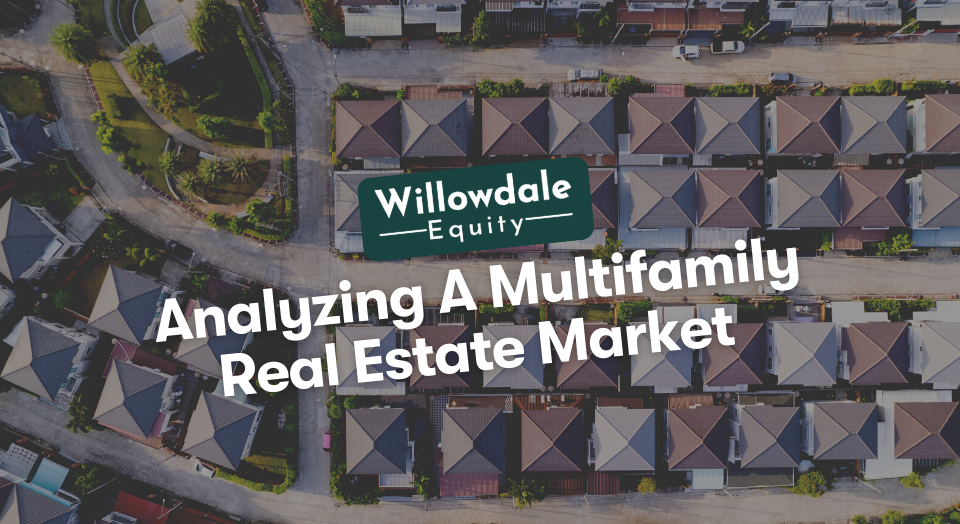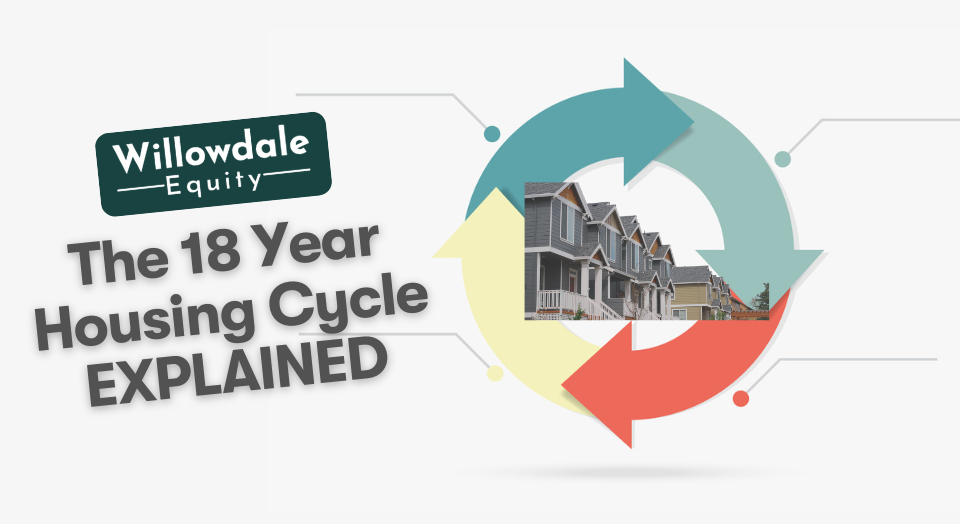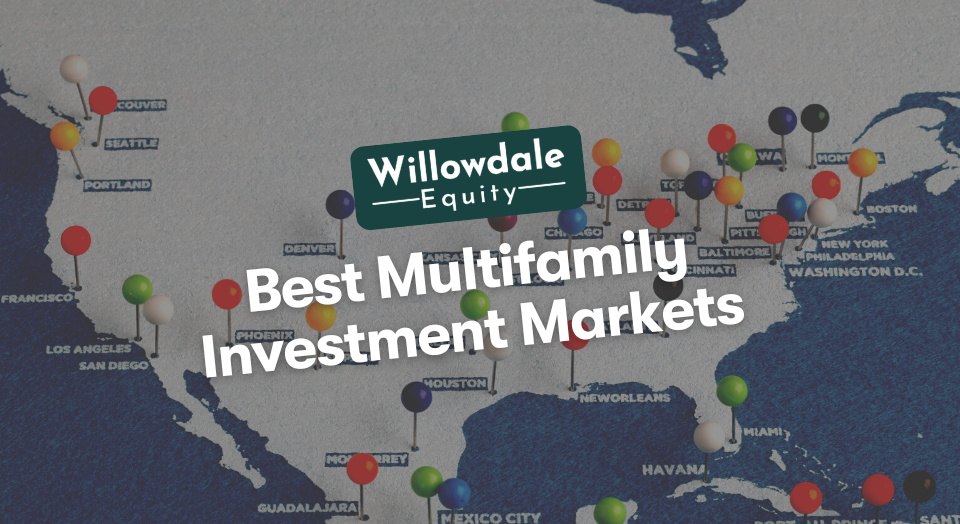
Multifamily Market Analysis: 6 Things We Look For When Analyzing A Market
This article is part of our passive investors guide on real estate syndications, available here.
How do you analyze the multifamily real estate market?
Multifamily market analysis requires a lot of research as you’re not making a short-term bet on a market; you’re making a long-term bet (potentially for the next few decades) on where things will be. As a long-term holder of an investment, you need to be bullish or comfortable with the security of that investment, and the protection of that investment is tied to its marketplace.
In the case of real estate investing, you’re making an educated investment that the marketplace for buying and selling real estate will still exist in that market in the future and that the marketplace of buyers will pay you more for your asset than what you bought it for.
Key Takeaways
-
Population growth is significant; migration and more people populating a given area naturally increase unit demand and rental pricing.
-
Although remote work has become more prevalent since COVID-19, having solid local employers in a given market drives median income levels up and attracts more people to a market.
-
Too much concentration in one sector or employer might put a local economy at risk if things don’t go well. Having multiple industries and employers diversifies that risk.
-
The real estate cycle has four core phases: recovery, expansion, and hyper-supply, followed by recession. These real estate cycles are pretty complex. Even if the economy is strong nationally, the particular real estate market that you’re looking at may not be moving in tandem.
What is Property Market Analysis? Or Comparative Market Analysis
The six factors we’ll discuss in the next section are more related to the study of whether a specific multifamily market is worth purchasing. This is sometimes referred to as a comparative market analysis (CMA) and oversees current property values in a market. Both of these analyses can be used in conjunction, as understating local property values will help you understand a potential market’scurrent’ and future value.
The goal of a CMA is to help establish an opinion of value for a property. It gathers data from recent sales, listings, and rentals (depending on what’s available) within your target area. It compares it to determine an estimated market value for the subject property. It’s important to note that a licensed real estate appraiser should always conduct CMAs to ensure accurate results.
Real Estate Market Analysis Example
A couple wants a single-family house for $450,000 but wants to talk to the seller about the amount. They ask their real estate agent to conduct comparative market analyses of the home and help them decide on a reasonable offer based on current market trends.
Once the real estate agent receives this information, they search for the sales price of recent comps around that area. Local real estate agents are good at determining the exact amount their buyers should offer on the subject property in that particular local market.
Multifamily Market Analysis 2024: 6 Things We Look For

The following are the 6 things we look for when analyzing a local real estate market for multifamily.
- Population Growth
- Employment Growth
- Landlord Friendly States
- Diversified Job Markets
- Supply & Demand
- What Stage of the Market Cycle We’re in
1.) Population Growth

Population growth is significant; migration and more people populating a given area naturally increase unit demand and rental pricing. Being in a flatlined market where population growth is very slow or even negative diminishes your ability to raise rents and fill vacancies.
Strong migration to a given market is one of the catalysts of natural appreciation in apartment values. Large migration increases the demand for a local market. It lowers the supply, which gives landlords the leverage to charge more for rent, increasing income and value. Low supply means more buildings to meet demand constraints, more building means more investment in the community, and more blue-collar and white-collar jobs to facilitate those projects. People moving to an area spearheads a whole ecosystem of growth for the entire municipality.
With strong population growth comes local municipality investment in upkeeping its city in terms of infrastructure to keep up with the growing strain and use. This might include investment in quality roads, bridges, and sidewalks which are essential for any economy to grow. Job creation rates will typically be higher in areas with good infrastructure because more people can commute to the site to work.
Having quality transportation options is also essential as people look for homes that allow them to commute easily without owning a car. Areas where Uber or Lyft operate are experiencing an increase in real estate values due to their convenience, so it’s something you want to consider when buying multifamily real estate properties.
2.) Employment Growth

Although remote work has become more prevalent since COVID-19, having solid local employers in a given market drives median income levels up and attracts more people to a market. Typically strong submarkets have a good mix of blue-collar and white-collar residents, and new employers set up a business or add more jobs to drive growth. Job growth is undoubtedly essential, but job growth alone isn’t what makes cities explode.
Places like Austin, San Francisco, and Nashville have experienced rapid population growth and solid job numbers, contributing to their skyrocketing real estate prices. So, when looking at markets to invest in, make sure you’re looking at population growth numbers and job growth numbers.
3.) Landlord Friendly States

The state and the local municipality where you landlord is very crucial to the success of your operations in the multifamily apartment business. For example, landlording can be difficult in a true blue state like California or New York. These states are more tenant-friendly and have very lenient eviction laws, where nonpaying residents can squat in an apartment unit without paying for almost a year before evicting.
Landlord-friendly regions are not just at the state level, local municipalities have their laws and regulations, so it’s essential to understand if your local submarket is landlord-friendly.
Get Access to EXCLUSIVE Tax-Advantaged Multifamily Investment Opportunities in Landlord Friendly States
4.) Diversified Job Markets

Too much concentration in one sector or employer might put a local economy at risk if things don’t go well. Having multiple industries and employers diversifies that risk. When General Motors closed down its manufacturing plant in Detroit, unemployment rose drastically, and the market took a big hit, and it is still attempting to recover fully.
When vital employers occupy a market, people from all across the country will migrate there for the opportunity to work. Having a variety of job sectors in a local economy spreads out that risk and can make it more stable. For example, a market with vital employers in transportation, manufacturing, retail trade, wholesale trade, technology, finance, public administration, arts, and entertainment gives job seekers more choices.
5.) Supply & Demand
This is the most fundamental analysis when understanding any market, and the multifamily real estate market is no exception. We look at the current and projected supply and demand to get an idea of how balanced (or imbalanced) the market is. This can help us identify potential opportunities or risks for investors. For example, if the market is currently experiencing high levels of demand, but the supply is projected to increase in the next year, it would suggest that prices could potentially rise as a result.
The average vacancy levels of a given market are crucial, as they signify potential supply constraints. Supply and demand are closely linked to population growth and migration because as more people move to a market, fewer units are available. This keeps occupancy high, which increases cash flow, and also allows a landlord to charge more for rent due to the scarcity of available units.
It’s important to note that builders and developers usually flock to that area to build new units when you see a city with explosive population growth. As a result, in some cases, builders will then overbuild, and there will be an oversupply of units, which has the opposite effect and sizzles off a market until more people migrate there.
6.) What Stage of the Market Cycle We’re in
The real estate cycle has four core phases: recovery, expansion, and hyper-supply, followed by recession. These real estate cycles are pretty complex. Even if the economy is strong nationally, the particular real estate market that you’re looking at may not be moving in tandem.
Across the United States, 25-30 markets would be in the developing phase at a given moment. What’s significant about real estate cycles is that each major city in the United States has its cycle. For example, Baltimore, MD, might be in the recession phase cycle of a market, while Denver, CO, might be in the mid-expansion phase.
Real estate market cycles are not easy to predict; as we all know, hindsight is 20/20, and also because we currently appear to be in one of the most extended real estate cycles recorded nationally. This means that you have to follow the fundamentals and symptoms of what a market is telling you of where it’s at, but also that if you are a long holder of real estate, you’ll always win if you intend to hold the property long-term. Unless you significantly overpay for it, you might have to wait a bit longer!
Related Read: Best Multifamily Investment Markets to Look Out For
Frequently Asked Questions About A Real Estate Market Analysis Example
It includes evaluating and examining the current market conditions, trends, and projections to determine what might happen with demand and prices in the coming weeks, months, or years. Real estate market analysis is crucial to the success of a real estate deal; this information needs to be compiled on the front end first to evaluate if the deal is worth the risk and has substantial upside potential. Secondly, to take some risk off the table by understanding the market pulse around the subject property.
Market analysis for a commercial real estate property requires an intense deep dive into the local economy. Commercial real estate landlords are purchasing commercial real estate as a cash-flowing investment. That being said, market analysis is crucial to ensuring that the local market has a robust economy with rising median income levels, job diversification, job growth, and natural population migration to continue holding or increasing demand levels.
NOI stands for Net Operating Income and refers to the cash flow that a multifamily property produces before servicing debt. The calculation to find the NOI for multifamily, you would make the following calculation (Gross Income – Operating Expenses= NOI).
Multifamily Market Analysis - Conclusion
We’ll also look at things like interest rates, GDP growth, employment levels, inflation rates, and consumer confidence for a more high-level analysis of the economy and how it impacts the multifamily real estate market. By understanding how these factors affect the market, we can better assess opportunities and risks for investors.
Monitoring prevailing trends is essential in any market, especially in a fast-paced one like the multifamily real estate market. By tracking things like construction starts, absorption rates, rent growth trends, and investor activity, we can better understand what to expect in the future. For example, if we see that rent growth is starting to slow down, it could indicate that the market is becoming saturated. Investors should start looking for new opportunities.
Conducting a local real estate market analysis for a multifamily property can be daunting if you don’t know what you should be looking for. It requires much more than evaluating comparable properties—focusing on market analysis before multifamily deal analysis is imperative.
Targeting solid population growth, employment growth, landlord-friendly states, diversified job markets, strong supply & demand, and understanding what stage of the market cycle you’re in will steer you toward a solid risk-adjusted market. It would help if you keep these factors as a foundation for your analysis and never purchase a property by solely underwriting the property without underwriting the market first.
Here at Willowdale Equity, we like to keep the following rule in mind. The success of the market and the property are hyper-correlated and therefore require a strong marriage, and in this marriage, divorce is not an option!
Interested In Learning More About PASSIVE Real Estate Investing In Multifamily Properties?
Get Access to the FREE 5 Day PASSIVE Real Estate Investing Crash Course.
In this video crash course, you’ll learn everything you need to know from A to Z
about passive investing in multifamily real estate.
We’ll cover topics like earned income vs passive income, the tax advantages, why multifamily, inflation, how syndications work, and much much more!




